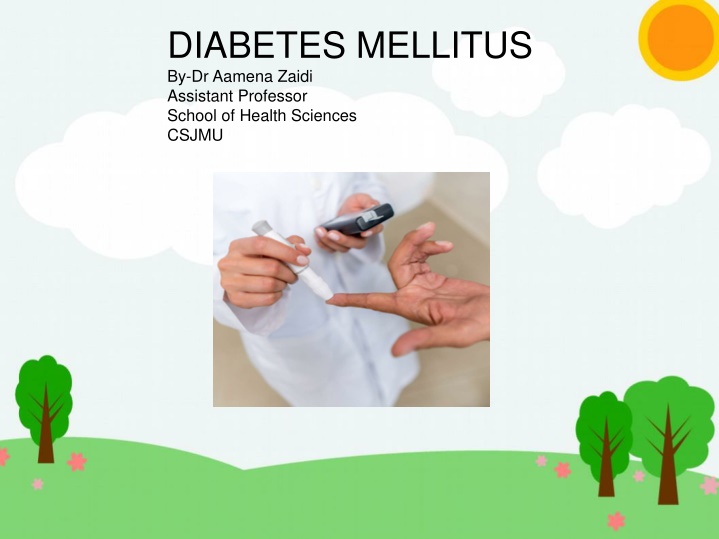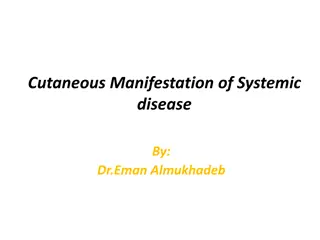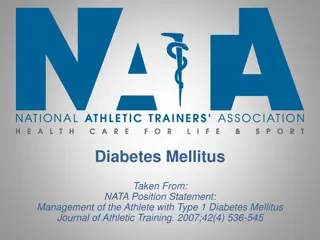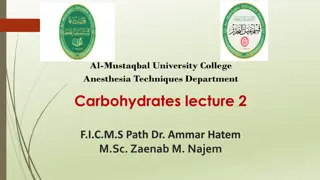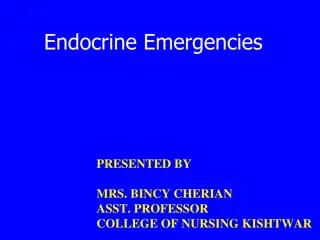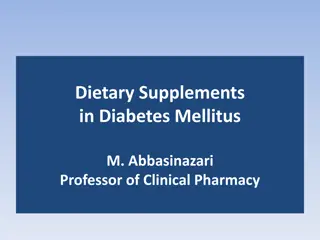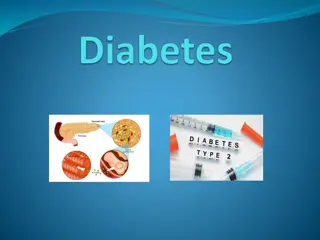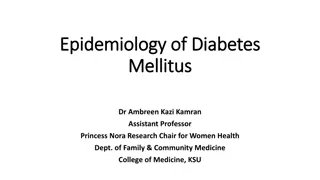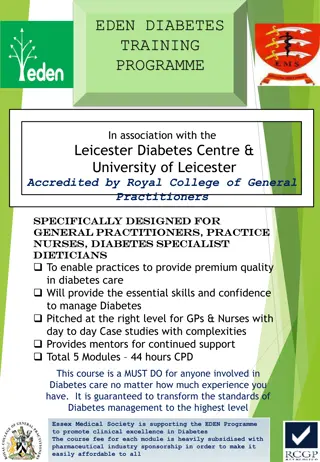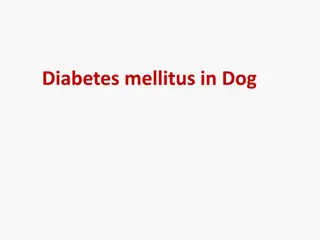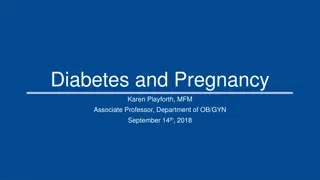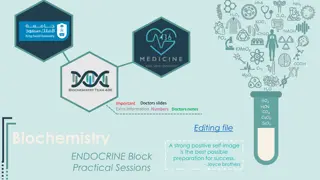DIABETES MELLITUS
Diabetes Mellitus is a chronic metabolic disorder characterized by elevated blood sugar levels. This article discusses the types, etiology, and prevalence of diabetes in India. Explore the causes, complications, and prevention strategies for managing this prevalent disease.
Download Presentation

Please find below an Image/Link to download the presentation.
The content on the website is provided AS IS for your information and personal use only. It may not be sold, licensed, or shared on other websites without obtaining consent from the author.If you encounter any issues during the download, it is possible that the publisher has removed the file from their server.
You are allowed to download the files provided on this website for personal or commercial use, subject to the condition that they are used lawfully. All files are the property of their respective owners.
The content on the website is provided AS IS for your information and personal use only. It may not be sold, licensed, or shared on other websites without obtaining consent from the author.
E N D
Presentation Transcript
DIABETES MELLITUS By-Dr Aamena Zaidi Assistant Professor School of Health Sciences CSJMU
INTRODUCTION Diabetes is a group of metabolic disorders characterized by abnormal metabolism, which results most notably in hyperglycemia , due to defects in insulin secretion, insulin action, or both. Diabetes is a serious chronic disease without a cure, and it is associated with significant morbidity and mortality. Diabetes is a serious disease associated with acute (due to hyperglycemia) and chronic (due to vascular damage) complications. 2
DIABETES MELLITUS "Diabetes" comes from the Greek word for "siphon", and implies that a lot of urine is made. The second term,"mellitus" comes from the Latin word, "mel" which means "honey", and was used because the urine was sweet. 3
Diabetes in india According to the Indian Council of Medical Research- Indian Diabetes study (ICMR-INDIAB), a national diabetes study, India currently has 63 million people with diabetes. India represents the world s second largest diabetes population after China. This is set to increase to over 100 million by 2030. The majority of people with diabetes (>90%) have Type 2 diabetes (T2DM). 4
Learning Objective At the end of this talk you should understand: What diabetes mellitus means ? The difference between types-1 and -2 diabetes How the different types are treated ?The reasons for the current epidemic of diabetes and how it can be prevented What the complications of diabetes are and how they can be prevented 5
Types of Diabetes TYPE -- 1 Diabetes Mellitus TYPE --2 Diabetes Mellitus Gestational Diabetes Mellitus Other uncommon types like 1. Genetic defects of beta cell function 2. Genetic defects in insulin action 3. Exocrine pancreatic defects 4. Infections 5. Drugs 6. Genetic syndromes like Down syndrome 7. PATHOPHYSIOLOGY 6
Etiology of Diabetes Both type 1 and type 2 diabetes share one central feature: elevated blood sugar (glucose) levels due to absolute or relative insufficiencies of insulin, a hormone produced by the pancreas. Type 1-Beta cell destruction completely leading to absolute insulin deficiency Type 2 combination of insulin resistance and Beta cell dysfunction 7
BASIC UNDERSTANDING OF GLUCOSE METABOLISM AND INSULIN ACTION 8
Action of Insulin It works in the following way: During and immediately after a meal, digestion breaks carbohydrates down into sugar molecules (of which glucose is one) and proteins into amino acids. Right after the meal, glucose and amino acids are absorbed directly into the bloodstream, and blood glucose levels rise sharply. (Glucose levels after a meal are called postprandial levels.) 9
The rise in blood glucose levels signals important cells in the pancreas, called beta cells, to secrete insulin, which pours into the bloodstream. Within 20 minutes after a meal insulin rises to its peak level. Insulin enables glucose to enter cells in the body, particularly muscle and liver cells. Here, insulin and other hormones direct whether glucose will be burned for energy or stored for future use. When insulin levels are high, the liver stops producing glucose and stores it in other forms until the body needs it again. 10
Pathophysiology of Type-1 Type 1 diabetes is characterized by destruction of the pancreatic beta cells. Most likely cause of these conditions is combined genetic, immunologic and possibly environmental (e.g. viral) factors contribute to cell destruction. This is abnormal response of the body in which the antibodies are direct against the normal tissues as if they were foreign and eventually can damage Islet of Langerhans , specific area of the pancreas that produce insulin, reducing the production of insulin or totally no production of insulin. 12
Pathophysiology of Type-2 Type 2 Diabetes Mellitus is a adult onset, and non-insulin dependent. There are 2 main problems related to insulin in type 2 diabetes, first one is insulin resistance (insulin do not bind with the special receptor on cell surface) and impaired insulin secretion (insulin secreting glands release irregular amount of insulin). 14
Gestational Diabetes Diabetes diagnosed during pregnancy Gestational diabetes is caused when the insulin receptors do not function properly. This is likely due to pregnancy related factors such as the presence of human placental lactogen that interferes with susceptible insulin receptors. Increased health risk to mother and baby Big baby,jaundice,still birth can occur for untreated cases Goes away after birth, but increased risk of developing Type 2 DM for mother and child 15
Differences between type-1 and type- DIABETES MELLITUS Type 1 Type 2 Middle aged, elderly Usually overweight/obese Family history usual Symptoms may be present for months/years Do not present with diabetic coma Insulin not necessarily required Previous diabetes in pregnancy These differences are not absolute Young age Normal BMI, not obese No immediate family history Short duration of symptoms (weeks) Can present with diabetic coma (diabetic ketoacidosis) Insulin required 16
SYMPTOMS OF NEW ONSET Polyurea Polydipsia Polyphagia Weight Less Fatigue 18
Symptoms Polyurea Polydipsia Dry mouth Ketoacidosis (shortness of breath) Hyperosmolar hyperglycemic non ketotic syndrome(fever,conf usion, weakness) Tremor Headache Pallor Dizziness Paresthesia Loss of coordination Anxiety Mood confusion Seizure 19
INVESTIGATION Fasting blood sugar Post prandial blood sugar HbA1C Lipid Profile To diagnose dyslipidaemia RBS can be done only if the patient follows up for the diagnostic tests after a meal 20
Fasting Blood Sugar Person to be tested should be on a normal diet for at least 3 days prior to testing. The test should be done after an overnight fast of 8 10 hours (no beverages including tea or coffee should be consumed), Draw a sample of blood after confirming fasting state of the patient. 21
Post prandial blood sugar Following the collection of the fasting blood sample for analysis of fasting serum glucose (FSG). Patient is advised to have a normal meal and return to the clinic after 2 hours following the meal. Draw a sample of blood after confirming the time of meal. 22
Hb1AC Person to be tested should be on a normal diet for at least 3 days prior to testing. The test should be done after an overnight fast of 8 10 hours Draw a sample of blood after confirming fasting state of the patient. 23
TREATMENT GUIDLINES Cigarette smoking Hypertension (BP >140/90 mmHg or on antihypertensive medication) Low HDL cholesterol (<40 mg/dL) Family history of premature CHD Age (men >45 years; women >55 years) 24
THANK YOU 25
